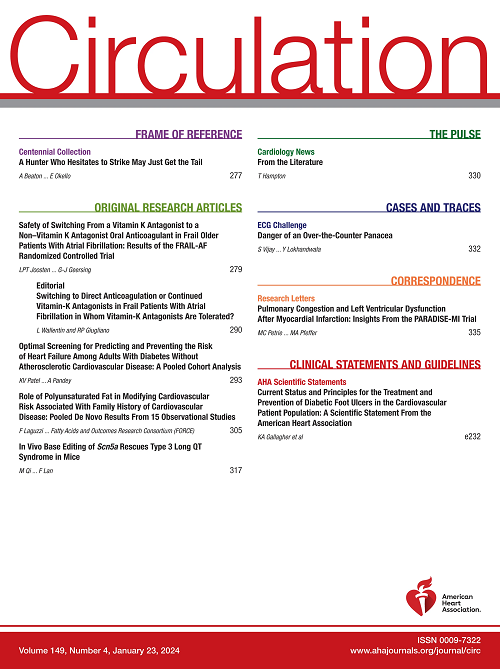Proteomic Signatures for Risk Prediction of Atrial Fibrillation.
IF 38.6
1区 医学
Q1 CARDIAC & CARDIOVASCULAR SYSTEMS
引用次数: 0
Abstract
BACKGROUND Proteomic signatures might improve disease prediction and enable targeted disease prevention and management. We explored whether a protein risk score derived from large-scale proteomics data improves risk prediction of atrial fibrillation (AF). METHODS A total of 51 680 individuals with 1459 unique plasma protein measurements and without a history of AF were included from the UKB-PPP (UK Biobank Pharma Proteomics Project). A protein risk score was developed with lasso-penalized Cox regression from a random subset of 70% (36 176 individuals, 54.4% women, 2155 events) and was tested on the remaining 30% (15 504 individuals, 54.4% women, 910 events). The protein risk score was externally replicated with the ARIC study (Atherosclerosis Risk in Communities; 11 012 individuals, 54.8% women, 1260 events). RESULTS The protein risk score formula developed from the UKB-PPP derivation set was composed of 165 unique plasma proteins, and 15 of them were associated with atrial remodeling. In the UKB-PPP test set, a 1-SD increase in protein risk score was associated with a hazard ratio of 2.20 (95% CI, 2.05-2.41) for incident AF. The C index for a model including CHARGE-AF (Cohorts for Heart and Aging Research in Genomic Epidemiology Atrial Fibrillation), NT-proBNP (N-terminal B-type natriuretic peptide), polygenic risk score, and protein risk score was 0.816 (95% CI, 0.802-0.829) compared with 0.771 (95% CI, 0.755-0.787) for a model including CHARGE-AF, NT-proBNP, and polygenic risk score (C-index change, 0.044 [95% CI, 0.039-0.055]). Protein risk score added to CHARGE-AF, NT-proBNP, and polygenic risk score resulted in a risk reclassification of 5.4% (95% CI, 2.9%-7.9%) with a 5-year risk threshold of 5%. In the decision curve, the predicted net benefit before and after the addition of protein risk score to a model including CHARGE-AF, NT-proBNP, and polygenic risk score was 3.8 and 5.4 per 1000 people, respectively, at a 5-year risk threshold of 5%. External replication of a protein risk score in the ARIC study showed consistent improvement in risk stratification of AF. CONCLUSIONS Protein risk score derived from a single plasma sample improved risk prediction of AF. Further research using proteomic signatures in AF screening and prevention is needed.房颤风险预测的蛋白质组学特征。
背景:蛋白质组学特征可以改善疾病预测,实现有针对性的疾病预防和管理。我们探讨了来自大规模蛋白质组学数据的蛋白质风险评分是否能改善心房颤动(AF)的风险预测。方法从UKB-PPP (UK Biobank Pharma Proteomics Project)中纳入51680例具有1459种独特血浆蛋白测量值且无房颤史的个体。采用套索惩罚Cox回归,从70%的随机子集(36 176人,54.4%的女性,2155个事件)中制定蛋白质风险评分,并对其余30%(15 504人,54.4%的女性,910个事件)进行测试。蛋白质风险评分与ARIC研究(社区动脉粥样硬化风险;11012个人,54.8%的女性,1260个项目)。结果根据UKB-PPP衍生集建立的蛋白质风险评分公式由165个独特的血浆蛋白组成,其中15个与心房重构相关。在UKB-PPP测试集中,蛋白质风险评分每增加1个标准差,心房颤动事件的风险比为2.20 (95% CI, 2.05-2.41)。包括CHARGE-AF(心房颤动基因组流行病学心脏与衰老研究队列)、NT-proBNP (n端b型利钠肽)、多基因风险评分和蛋白质风险评分在内的模型的C指数为0.816 (95% CI, 0.802-0.829),而包括CHARGE-AF、NT-proBNP、多基因风险评分(C-index change, 0.044 [95% CI, 0.039 ~ 0.055])。蛋白质风险评分与CHARGE-AF、NT-proBNP和多基因风险评分相结合,导致风险重分类为5.4% (95% CI, 2.9%-7.9%), 5年风险阈值为5%。在决策曲线中,在5年风险阈值为5%的情况下,在包括CHARGE-AF、NT-proBNP和多基因风险评分的模型中加入蛋白质风险评分前后的预测净效益分别为3.8 / 1000和5.4 / 1000。ARIC研究中蛋白质风险评分的外部复制显示AF风险分层的一致性改善。结论来自单一血浆样本的蛋白质风险评分改善了AF的风险预测,需要进一步研究使用蛋白质组学特征来筛查和预防AF。
本文章由计算机程序翻译,如有差异,请以英文原文为准。
求助全文
约1分钟内获得全文
求助全文
来源期刊

Circulation
医学-外周血管病
CiteScore
45.70
自引率
2.10%
发文量
1473
审稿时长
2 months
期刊介绍:
Circulation is a platform that publishes a diverse range of content related to cardiovascular health and disease. This includes original research manuscripts, review articles, and other contributions spanning observational studies, clinical trials, epidemiology, health services, outcomes studies, and advancements in basic and translational research. The journal serves as a vital resource for professionals and researchers in the field of cardiovascular health, providing a comprehensive platform for disseminating knowledge and fostering advancements in the understanding and management of cardiovascular issues.
 求助内容:
求助内容: 应助结果提醒方式:
应助结果提醒方式:


